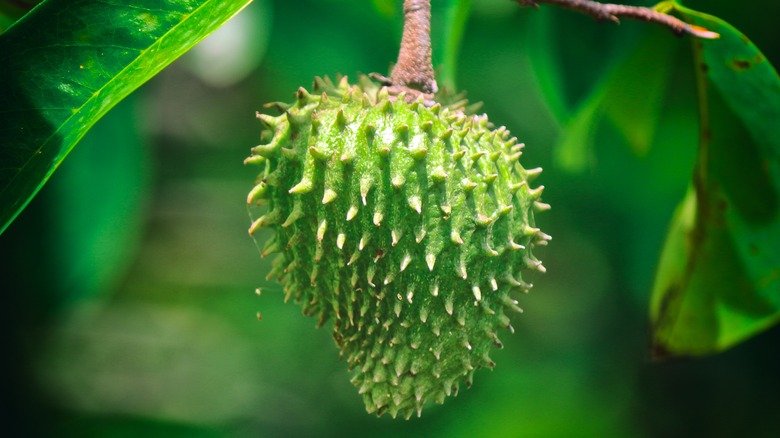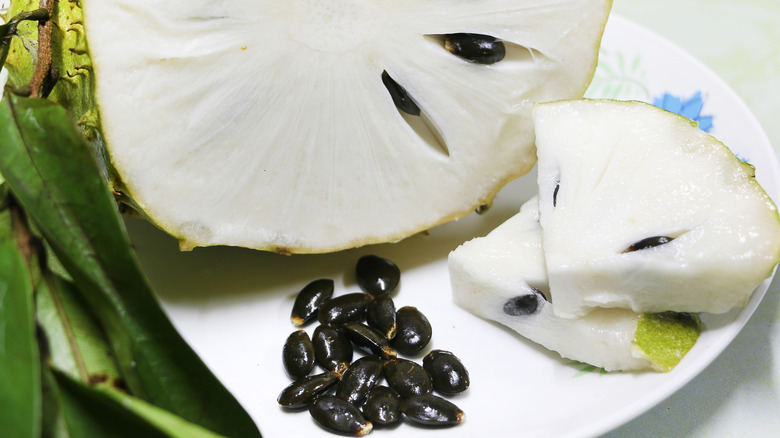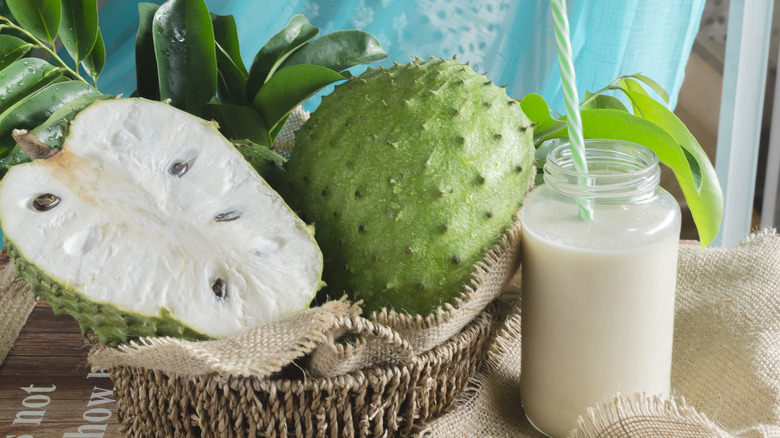How To Eat Soursop Fruit The Right Way
It's easy to get in a rut and pick up the same old favorites every time you head to the grocery store. And it makes sense: Food can be expensive, and it might feel safer to buy the tried-and-true products instead of purchasing something that you might not like. But don't be afraid to mix things up from time to time, like trying unexpected food combinations that are absolutely delicious — we're looking at cheese and apple pie — or choosing a single, fun new item. Fruit is a great place to start because who doesn't love tropical fruit?
We're not talking about your standard pineapples, though; we're talking about soursop. If you love cocktails like lime sour, or if you're the type to always reach for the Sour Patch Kids, you'll probably love soursop. This tropical (and subtropical) fruit is often described as sitting at the intersection of strawberry and pineapple flavors with a sour citrus bite.
So, how do you eat soursop? First and perhaps most importantly, don't eat the seeds — they're toxic. Don't let that dissuade you: The fruit itself is associated with all kinds of nutritional benefits and is lauded for supposed anti-inflammatory, antioxidant, and antibacterial properties. This delightful fruit is perfect for cocktails, drinks, dessert, and breakfast, but it all starts with choosing the right fruit and prepping it safely.
Pick and prep soursop the right way
Depending on where you live, fresh soursop can be hard to find — most major chains probably aren't going to carry it. If you're fortunate enough to have a nearby Asian market or a store that carries specialty produce, tropical fruit, or West Indian cuisine, you might be lucky enough to find fresh ones available. If that's the case, look for sousops with a firmness similar to what you'd expect from a ripe peach, and the color should be green drifting toward yellow — a sign they're ripening.
If you're not planning on using it for a few days, you can definitely get a greener fruit and let it ripen at home. If you can't find fresh soursop, frozen is a great alternative that can be used for almost all of the best uses for fresh.
Once soursop is fully ripe, you're not going to want to let it sit for more than a day or two. Afterward, it's time to prep it: Cut it in half, and you can either scoop out the white flesh or slice it into chunks. It can be eaten just like that — avoiding the seeds — but the stringy texture that it sometimes has might turn some people away from eating it straight.
Soursop makes a great beverage or dessert
There are a ton of options for enjoying soursop besides eating it as is, starting with smoothies. Whip up a banana soursop nut smoothie or smoothies with other tropical fruits like papaya, mango, or pineapple. If you're wondering whether or not it works well alongside coconut, it's actually a pretty perfect combination. You're not going to go wrong with the sweet-sour flavor and creamy texture, and it can even be used to sweeten up vegetable-heavy smoothies made with greens like kale and spinach.
It makes sense, then, that soursop makes an excellent drink — alcoholic or not. Just mix pureed soursop with any of the tropical flavors above. If you're a fan of kicking back with a classic daiquiri on a hot summer afternoon, you can definitely add soursop puree for a fun change to the flavors. Prefer a classic margarita? It's great with soursop added, too.
Aside from beverages, there are plenty of dessert options. Soursop can be used in a deliciously citrusy ice cream or creamy mousse, or if you're a fan of a light and velvety key lime pie, you should definitely keep in mind that soursop makes a great cream pie, too. And it might be the secret ingredient that you didn't know your cheesecake needed. Soursop is surprisingly versatile, and once you give this hard-to-find fruit a try, you'll be looking for it everywhere.


